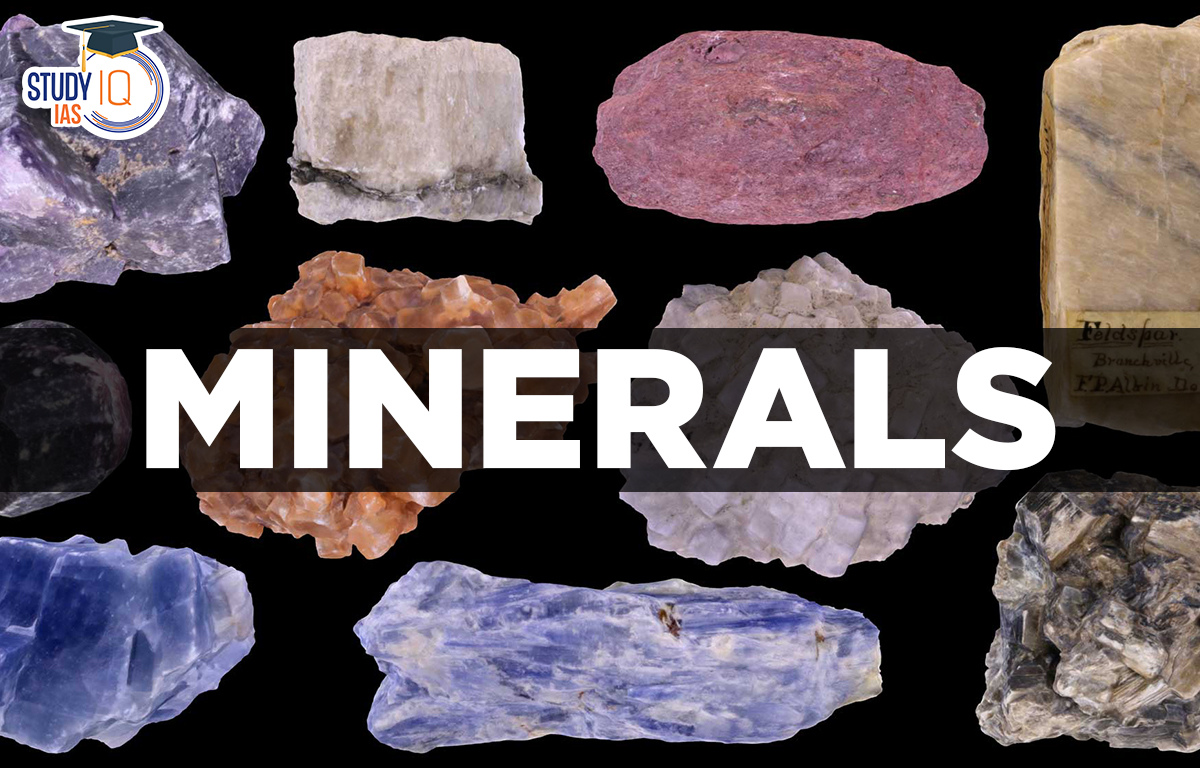Table of Contents
Minerals are valuable natural resources, they constitute the important raw material for many basic industries and are major resources for development. A Mineral has a definite chemical composition, atomic structure and is formed by inorganic processes. Mineral generally occur in the earth’s crust in the form of ore, Inida has a large number of resources of metallic and non metallic minerals. A Total of 95 minerals are produced within a country, of which 10 are metallic minerals, 3 atomic minerals and 55 are other minerals. This topic is essential for UPSC aspirants, as questions related to mineral resources frequently appear in both Preliminary and Main exams. This article provides a detailed overview of minerals, their classification, and their significance in various sectors.
Definition of Minerals
Minerals are naturally occurring inorganic substances with a defined chemical composition and a crystalline structure. They are solid at room temperature and can be composed of one or more elements. The study of minerals encompasses their physical properties, classification, and economic importance.
Characteristics of Minerals
- Chemical Composition: Minerals have a specific chemical formula. For instance, quartz is composed of silicon dioxide (SiO₂).
- Crystal Structure: The internal arrangement of atoms in minerals forms a crystal lattice, which determines the mineral’s physical properties.
- Physical Properties:
- Hardness: Measured by the Mohs scale, it indicates a mineral’s resistance to scratching. For example, diamond (10 on the Mohs scale) is the hardest mineral.
- Luster: Refers to the way light reflects off the mineral’s surface. It can be metallic, glassy, or dull.
- Cleavage: The tendency of a mineral to break along flat planes. Mica, for instance, has perfect cleavage in one direction.
- Fracture: How a mineral breaks when it does not have cleavage planes. Examples include conchoidal fracture in quartz.
- Color and Streak: The color of a mineral and its powdered form, respectively. Streak can sometimes differ from the mineral’s color.
- Specific Gravity: The density of a mineral relative to water, indicating how heavy a mineral is for its size.
Types of Minerals
- Metallic Minerals:
- Ferrous Minerals: Contain iron. Key examples include:
- Iron Ore: Found primarily as hematite and magnetite. Major deposits are in Odisha, Jharkhand, Karnataka, and Goa.
- Manganese: India has the 6th largest reserve of manganese in the world. It is found in the sedimentary rocks in the Dharawar system. Essential for steel production, mainly extracted from Odisha and Madhya Pradesh.
- Non-Ferrous Minerals: Do not contain iron. Important types include:
- Bauxite: The primary ore of aluminum, found in Odisha, Jharkhand, and Chhattisgarh.
- Copper: Used in electrical wiring, with deposits in Jharkhand, Madhya Pradesh, and Rajasthan.
- Ferrous Minerals: Contain iron. Key examples include:
- Non-Metallic Minerals:
- Industrial Minerals: Used in manufacturing and construction.
- Limestone: Used in cement production and building materials.
- Gypsum: Used in plaster and drywall.
- Gemstones: Valued for their beauty. Notable examples are diamonds, sapphires, and rubies.
- Energy Minerals: Important for energy production.
- Coal: A primary source of energy, with major fields in Jharkhand, Chhattisgarh, and West Bengal.
- Petroleum: Found in Gujarat, Assam, and offshore Mumbai High.
- Natural Gas: Extracted from fields in Gujarat, Mumbai High, and the Krishna-Godavari basin.
- Atomic Mineral: Uranium and Thorium are the major minerals for the production of atomic energy, Uranium is mined directly whereas thorium is obtained from Monatize sand found in Kerala
- Industrial Minerals: Used in manufacturing and construction.
Classification of Minerals
- By Chemical Composition:
- Silicates: Minerals containing silicon and oxygen, such as quartz and feldspar.
- Carbonates: Contain carbon and oxygen, such as calcite and dolomite.
- Oxides: Contain oxygen and another element, such as hematite (Fe₂O₃).
- Sulfides: Contain sulfur and another element, such as pyrite (FeS₂).
- Halides: Contain halogen elements, such as halite (NaCl).
- By Physical Properties:
- Hardness: Ranges from talc (1) to diamond (10).
- Cleavage and Fracture: Essential for mineral identification.
- Luster: Includes metallic, vitreous, and pearly.
- By Origin:
- Primary Minerals: Formed directly from magma or crystallization, such as quartz.
- Secondary Minerals: Result from the alteration of primary minerals, such as clay minerals.
Economic Importance of Minerals
Minerals are vital for economic development and industrial growth. They are essential in sectors such as construction, manufacturing, energy production, and technology. The extraction and processing of minerals contribute significantly to national economies, providing raw materials for various industries and creating employment opportunities.
- Construction: Minerals like limestone and gypsum are used in cement and plaster production.
- Manufacturing: Metals like iron, aluminum, and copper are crucial for building machinery, vehicles, and infrastructure.
- Energy Production: Coal, petroleum, and natural gas are primary sources of energy.
- Technology: Silicon and rare earth elements are vital for electronics and high-tech applications.
Mineral Belts in India
India is rich in mineral resources, distributed across various regions:
- North-Eastern Peninsular Belt: Includes the Chhota Nagpur Plateau, rich in iron, coal, manganese, bauxite, and mica.
- Central Belt: Features manganese, bauxite, limestone, and coal. Prominent states are Chhattisgarh, Madhya Pradesh, and Maharashtra.
- Southern Belt: Known for its ferrous minerals and lignite, located in Karnataka and Tamil Nadu.
- South-Western Belt: Contains iron ore and garnet, found in Karnataka and Goa.
- North-Western Belt: Rich in non-ferrous metals like copper, lead, and zinc, located in Rajasthan and Gujarat.
- Indian Ocean Belt: The continental shelf(it is a bed sloping gradually and bordering the continent) of the Arabian sea and the Bay of Bengal are rich in mineral oil and natural gas
Top Mineral Producing states
|
Mineral |
Mines |
Top producing states |
Top reserves in |
|
Iron Ore Metallic (Ferrous) |
|
1. Orissa |
1. Orissa |
|
Manganese Metallic (Ferrous) |
|
1. MP 2. Maharashtra |
1. Orissa |
|
Chromite Metallic (Ferrous) |
|
1. Orissa |
1. Sukinda Valley (OR) |
|
Nickel Metallic (Ferrous) |
|
1. Orissa |
1. Orissa |
|
Cobalt Metallic (Ferrous) |
|
1. Jharkhand |
|
|
Bauxite Metallic (Non-Ferrous) |
|
1. Orissa |
1. Junagarh (GJ) |
|
Copper Metallic (Non-Ferrous) |
|
1. Madhya Pradesh |
1. Rajasthan |
|
Gold Metallic (Non-Ferrous) |
|
1. Karnataka |
1. Bihar |
|
Silver Metallic (Non-Ferrous) |
|
1. Rajasthan |
1. Rajasthan |
|
Lead Metallic (Non-Ferrous) |
|
1. Rajasthan |
1. Rajasthan |
|
Tin Metallic (Non-Ferrous) |
|
Chhattisgarh (the only state in India) |
Chhattisgarh |
|
Magnesium Metallic (Non-Ferrous) |
|
1. Tamil Nadu |
1. Tamil Nadu |
|
Limestone Non-Metallic |
|
1. Rajasthan |
1. Andhra Pradesh |
|
Mica Non-Metallic |
|
1. Andhra Pradesh |
|
|
Dolomite Non-Metallic |
|
1. Chhattisgarh |
1. Chhattisgarh |
|
Asbestos Non-Metallic |
|
1. Rajasthan |
1. Rajasthan |
|
Kyanite Non-Metallic |
|
1. Jharkhand |
1. Maharashtra |
|
Gypsum Non-Metallic |
|
1. Rajasthan |
1. Rajasthan |
|
Diamond Non-Metallic |
|
1. Madhya Pradesh – only diamond-producing state |
|
|
Coal Non-Metallic (Energy) |
|
1. Chhattisgarh |
1. Jharkhand |
|
Petroleum Non-Metallic (Energy) |
|
1. Maharashtra |
1. Gujarat |
|
Uranium Atomic |
|
1. Andhra Pradesh |
1. Jharkhand |
|
Thorium Atomic |
1. Kerala |
1. Andhra Pradesh |
Minerals UPSC
Knowing about minerals, their types, features, and importance is very important for UPSC preparation. This knowledge helps in answering questions and understanding how minerals are important to national development. Students should pay attention to how minerals are classified, where they are found, and how they are used. This will improve their exam performance and help them understand their significance for India’s economy and industry.


 Story of Meera Bai and Her Devotion For ...
Story of Meera Bai and Her Devotion For ...
 Desert Climate, Distribution, Climatic C...
Desert Climate, Distribution, Climatic C...
 Deserts of India Map, Features of Thar D...
Deserts of India Map, Features of Thar D...





















